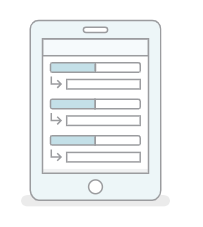Form Builder Features
About
TrueContext has introduced a set of features that enable more powerful and adaptable forms and mobile workflows than ever before.
These changes enable a new type of form; forms that are dynamic, that react and adapt to the job context in real-time, and guide workers through different tasks seamlessly -- with a better appearance and greater usability for mobile users.
With that also comes new ways of building and managing forms. The TrueContext Form Builder![]() The Form Builder is the tool that form designers use to create forms. In the Form Builder, accessed from the TrueContext Web Portal, form designers can add and edit pages, sections, and questions, as well as attach data destinations and configure the form's settings. has been completely rebuilt from the ground up -- with a new visual design that makes building forms faster, easier, and more intuitive.
The Form Builder is the tool that form designers use to create forms. In the Form Builder, accessed from the TrueContext Web Portal, form designers can add and edit pages, sections, and questions, as well as attach data destinations and configure the form's settings. has been completely rebuilt from the ground up -- with a new visual design that makes building forms faster, easier, and more intuitive.
New Features
|
New Form Building Interface A new design, great usability, and better performance makes quick work of building powerful and dynamic forms and workflows. |
 |
|
Mobile Form "Sections" Sections divide questions up into logical groups within a form page, adding more structure to mobile forms and making them easier for users to navigate and complete. |
 |
|
Repeatable Sections Repeatable Sections allow users to quickly enter a variable number of line items into a form -- like parts or materials in a work order. The summary table makes it easy for mobile users to review their work, and gives forms a more attractive and structured appearance. Repeatable sections enable far more lightweight forms that are easier and faster for administrators to manage; build more dynamic and flexible forms for a fraction of the form-building work. |
 |
|
Additional Comments Conditionally show a follow-up/comments field based on the response to a question. Apply this to many different types of questions, and optionally make the comments field required to enforce that mobile users provide details. |
 |
|
Advanced Conditional Logic Advanced Conditional Logic uses "If This, Then That" statements to adapt the workflow of a form based on a mobile user's inputs and the context of the job. Streamline field workflows by guiding users down different paths, providing in-context training or alerts, or enforcing the collection of additional information in specific scenarios. Business users can easily build their custom business logic into any form with the intuitive form building interface -- no code required. |
 |
|
Exceptions are used to categorize identified problems and provide color-coded visual feedback to mobile users as they fill out a form. They are a great tool for building complex inspections or checklists, where results can indicate major or minor issues that need to be corrected. |
 |
|
Custom Documents, and New Document Formats New Custom Documents can be built in Excel, or using HTML & CSS. Build documents with conditional formatting and more, configured to look exactly like your paper forms. Default PDF, Word and HTML documents have a new look that gives you more control to better highlight your branding.
|

|